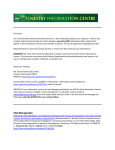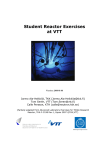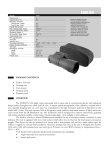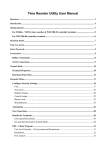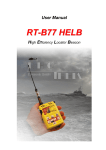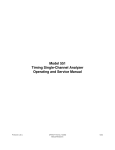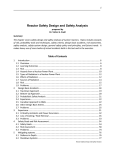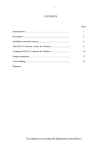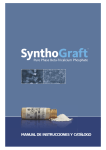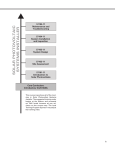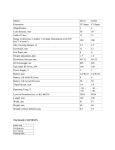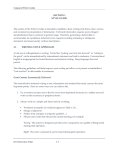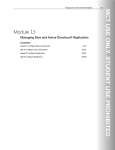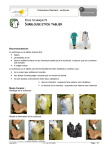Download c:Yc~~ -f 6o&JOo~
Transcript
UNITED STATES NUCLEAR REGULATORY COMMISSION REGION I 475 ALLENDALE ROAD KING OF PRUSSIA, PENNSYLVANIA 19406·1415 April 28, 2010 Mr. Charles G. Pardee Senior Vice President, Exelon Generation Company LLC President and Chief Nuclear Officer, Exelon Nuclear 4300 Winfield Rd. Warrenville, IL 60555 SUBJECT: PEACH BOTTOM ATOMIC POWER STATION, UNITS 2 AND 3 - NRC EVALUATION OF CHANGES, TESTS, AND EXPERIMENTS AND PERMANENT MODIFICATIONS TEAM INSPECTION REPORT 05000277/2010006 AND 05000278/2010006 Dear Mr. Pardee: On March 19, 2010, the U.S. Nuclear Regulatory Commission (NRC) completed an inspection at the Peach Bottom Atomic Power Station. The enclosed inspection report documents the inspection results, which were discussed on March 19, 2010, with Mr. W. Maguire, and other members of your staff. The inspection examined activities conducted under your license as they relate to safety and compliance with the Commission's rules and regulations and with the conditions of your license. In conducting the inspection, the team reviewed selected procedures, calculations and records, observed activities, and interviewed station personnel. Based on the results of this inspection, no findings of significance were identified. In accordance with 10 CFR 2.390 of the NRC's "Rules of Practice," a copy of this letter, its enclosure, and your response (if any) will be available electronically for public inspection in the NRC Public Document Room or from the Publicly Available Records (PARS) component of the NRC's document system (ADAMS). ADAMS is accessible from the NRC Web site at http://www.nrc.gov/reading-rm/adams.html(the Public Electronic Reading Room). Sincerely, c:Yc~~ -f 6o&JOo~ Chief~! ~ Lawrence T. Doerflein, Engineering Branch 2 Division of Reactor Safety Docket Nos.: 50-277; 50-278 License Nos.: DPR-44, DPR-56 Enclosure: Inspection Report No. 05000277/2010006 and 05000278/2010006 w/Attachment: Supplemental Information cc w/encl: Distribution via ListServ April 28, 2010 Mr. Charles G. Pardee Senior Vice President, Exelon Generation Company LLC President and Chief Nuclear Officer, Exelon Nuclear 4300 Winfield Rd. Warrenville, IL 60555 SUBJECT: PEACH BOTTOM ATOMIC POWER STATION, UNITS 2 AND 3 - NRC EVALUATION OF CHANGES, TESTS, AND EXPERIMENTS AND PERMANENT MODIFICATIONS TEAM INSPECTION REPORT 05000277/2010006 AND 05000278/2010006 Dear Mr. Pardee: On March 19, 2010, the U.S. Nuclear Regulatory Commission (NRC) completed an inspection at the Peach Bottom Atomic Power Station. The enclosed inspection report documents the inspection results, which were discussed on March 19,2010, with Mr. W. Maguire, and other members of your staff. The inspection examined activities conducted under your license as they relate to safety and compliance with the Commission's rules and regulations and with the conditions of your license. In conducting the inspection, the team reviewed selected procedures, calculations and records, observed activities, and interviewed station personnel. Based on the results of this inspection, no findings of significance were identified. In accordance with 10 CFR 2.390 of the NRC's "Rules of Practice," a copy of this letter, its enclosure, and your response (if any) will be available electronically for public inspection in the NRC Public Document Room or from the Publicly Available Records (PARS) component of the NRC's document system (ADAMS). ADAMS is accessible from the NRC Web site at http://www.nrc.gov/reading-rm/adams.html(the Public Electronic Reading Room). Sincerely, IRA! Lawrence T. Doerflein, Chief Engineering Branch 2 Division of Reactor Safety Docket Nos.: 50-277,50-278 License Nos.: DPR-44, DPR-56 Enclosure: Inspection Report No. 05000277/2010006 and 05000278/2010006 w/Attachment: Supplemental Information cc w/encl: Distribution via ListServ ADAMS ACCESSION NO. ML 101180465 SUNSI Review Complete: LTO (Reviewer'S Initials) DOCUMENT NAME: G:\DRS\Engineering Branch 3\Lilliendahl\PB Mods Report 2010006 rev1.doc After declaring this document ~An Official Aaencv Record- it will be released to the Public. To receive a copy of this document, Indicate In the box: ~C";;; C()py__ 'Nithout attachmenVenclosure "E";;; COpy INith attachment/enclosure "N" OFFICE RIIDRS NAME DATE JLilliendahl1 04/14/10 I RI/DRP PKrohnl 04/15/10 I RI/DRS LDoerfJeinl 04/28/10 OFFICIAL RECORD COpy I I =No copy I C. Pardee 2 Distribution w/encl: (via E-mail) S. Collins, RA (R10RAMAIL Resource) M. Dapas, ORA (R10RAMAIL Resource) D. Lew, DRP (R1DRPMAIL Resource) J. Clifford, DRP (R1DRPAMAIL Resource) D. Roberts, DRS (R1DRSMail Resource) P. Wilson, DRS (R1DRSMail Resource) P. Krohn, DRP A. Rosebrook, DRP E. Torres, DRP J. Bream, DRP F. Bower, DRP, SRI A. Ziedonis, DRP, RI S. Schmitt, DRP, OA L. Trocine, RI OEDO D. Bearde, DRS RidsNrrPMPeachBottom Resource [email protected] L. Doerflein, DRS J. Ulliendahl, DRS u.s. NUCLEAR REGULATORY COMMISSION REGION I Docket No.: 50-277 and 50-278 License No.: DPR-44 and DPR-56 Report No.: 05000277/2010006 and 05000278/2010006 Licensee: Exelon Generation Company, LLC (Exelon) Facility: Peach Bottom Atomic Power Station, Units 2 and 3 Location: Delta, Pennsylvania Inspection Period: March 1, 2010 through March 19, 2010 Inspectors: J. Lilliendahl, Reactor Inspector, Division of Reactor Safety (DRS), Team Leader K. Mangan, Senior Reactor Inspector, DRS M. Orr, Reactor Inspector, DRS S. Rich, Reactor Engineer, NSPDP (in-training) G. Figueroa, Reactor Systems Engineer, Office of Nuclear Regulatory Research (RES) (observer) Approved By: Lawrence T. Doerflein, Chief Engineering Branch 2 Division of Reactor Safety Enclosure SUMMARY OF FINDINGS IR 05000277/2010006 and 05000278/2010006; 3/1/2010 - 3/19/2010; Peach Bottom Atomic Power Station, Units 2 and 3; Engineering Specialist Plant Modifications Inspection. This report covers a two week on-site inspection period of the evaluations of changes, tests, or experiments and permanent plant modifications. The inspection was conducted by three region based engineering inspectors, one inspector in training, and one observer. No findings of significance were identified. The NRC's program for overseeing the safe operation of commercial nuclear power reactors is described in NUREG-1649, "Reactor Oversight Process," Revision 4, dated December 2006. A. NRC-Identified and Self-Revealing Findings No findings of significance were identified. B. Licensee-Identified Violations None. ii Enclosure REPORT DETAILS 1. REACTOR SAFETY Cornerstones: Initiating Events, Mitigating Systems, and Barrier Integrity 1R17 Evaluations of Changes, Tests, or Experiments and Permanent Plant Modifications (IP71111.17) .1 a. Evaluations of Changes, Tests, or Experiments (22 samples) Inspection Scope The team reviewed six safety evaluations to determine whether the changes to the facility or procedures, as described in the Updated Final Safety Analysis Report (UFSAR), had been reviewed and documented in accordance with 10 CFR 50.59 requirements. In addition, the team evaluated whether Exelon had been required to obtain NRC approval prior to implementing the change. The team interviewed plant staff and reviewed supporting information including calculations, analyses, design change documentation, procedures, the UFSAR, the Technical Specifications (TSs), and plant drawings, to assess the adequacy of the safety evaluations. The team compared the safety evaluations and supporting documents to the guidance and methods provided in Nuclear Energy Institute (NEI) 96-07, "Guidelines for 10 CFR 50.59 Evaluations," as endorsed by NRC Regulatory Guide 1.187, "Guidance for Implementation of 10 CFR 50.59, Changes, Tests, and Experiments," to determine the adequacy of the safety evaluations. The team also reviewed a sample of sixteen 10 CFR 50.59 screenings for which Exelon had concluded that no safety evaluation was required. These reviews were performed to assess whether Exelon's threshold for performing safety evaluations was consistent with 10 CFR 50.59. The sample included design changes, calculations, and procedure changes. The team reviewed the safety evaluations that Exelon had performed and approved during the time period covered by this inspection (Le., since the last modifications inspection). The screenings and applicability determinations were selected based on the safety significance, risk significance, and complexity of the change to the facility. In addition, the team compared Exelon's administrative procedures used to control the screening, preparation, review, and approval of safety evaluations to the guidance in NEI 96-07 to determine whether those procedures adequately implemented the requirements of 10 CFR 50.59. The reviewed safety evaluations and screenings are listed in the attachment. b. Findings No findings of significance were identified. Enclosure 2 .2 Permanent Plant Modifications (10 samples) .2.1 High Pressure Service Water (HPSW) Orifice Changes a. Inspection Scope The team reviewed a modification (Engineering Change Request (ECR) 06-00023) to the HPSW system outlet piping from the Unit 3 '0' residual heat removal (RHR) heat exchanger. The modification installed a multi-hole orifice plate and removed the plugs from another orifice plate in the same line. This change was necessary following the replacement of internal components of the Unit 3 '0' RHR heat exchanger outlet valve, because the newer assembly had a greater resistance coefficient and resultant pressure drop. The team conducted the review to verify that the design bases, licensing bases, and performance capability of the HPSW system had not been degraded by the modification. The team discussed the modification and design basis with design and system engineers to assess the adequacy of the modification and to verify that the HPSW system had been fully restored to service. Post modification test results were reviewed to ensure the HPSW pressure and flow rate met the acceptance criteria. The 10 CFR 50.59 screening determination associated with this modification was also reviewed as described in section 1R17.1 of this report. Additional documents reviewed are listed in the attachment. b. Findings No findings of significance were identified . .2.2 a. 'E1' Emergency Diesel Generator (EDG) Speed Switch Replacement Inspection Scope The team reviewed a modification (ECR 07-00284) which replaced the 'E l' EDG engine speed switch. Exelon implemented this modification following erratic behavior of the speed switch during routine surveillance testing. Exelon had previously upgraded the speed switch to a newer model, and did not have any available new spares. The modification re-installed the original model speed switch. The original model speed switch had a successful history of use since plant construction and was determined to meet the criteria of an equivalent change. The team conducted the review to ensure that the design bases, licensing bases, and performance capability of the EDG had not been adversely affected by the modification. The team reviewed the high and low speed switch setpoints to verify there were no adverse impacts to operating margins and that the speed switch functioned in accordance with the design basis. The team reviewed post maintenance test data to confirm that the replacement speed switch met the acceptance criteria and the EDG Enclosure 3 was operable. Additionally, the team reviewed the associated work order packages and conducted interviews with design and system engineers regarding the design, installation, and testing of the switches to verify that the modification was adequate. The team walked down the 'E1' EDG to assess the system configuration. The documents reviewed are listed in the attachment. b. Findings No findings of significance were identified . .2.3 a. 'E1' EDG Tachometer Drive Coupling Shaft/Pin Replacement Inspection Scope The team reviewed a modification (ECR 09-00360) associated with the replacement of the 'E1' EDG tachometer drive coupling shaft and pins. These components support the EDG's automatic start design function. Exelon implemented this modification following the determination that the tachometer drive coupling shaft and pins had been damaged during engine reassembly. The replacement drive assembly did not include the required shaft and pins, which transfer camshaft rotation through the tachometer drive to the speed switch. This modification consisted of the fabrication of a new shaft and pins identical to the existing components. The team evaluated the change to confirm that the design bases, licensing bases, and performance capability of the EDG had not been inadvertently degraded by the modification. The team reviewed the plan to fabricate the replacement parts to evaluate the suitability of the replacement material. The team interviewed design engineers with regards to the technical evaluation of material used, material specifications, risk assessment, .fabrication and acceptable machining tolerances, single point vulnerability review, and acceptance testing. The team reviewed performance test data obtained after the installation of the tachometer drive coupling and the on-site manufactured shaft and pins to verify proper performance of the 'E1' EDG speed switch. The team performed a walkdown of 'E1' EDG to assess the system configuration. The documents reviewed are listed in the attachment. b. Findings No findings of significance were identified . .2.4 a. Core Spray Pump Technical Specification and In-service Test Acceptance Criteria Inspection Scope The team reviewed the design change (ECR 08-00074) that revised the acceptance criteria for the core spray pump surveillance tests. Exelon revised calculation ME-0073, Core Spray Pump In-Service Testing Acceptance Criteria, as well as the TS surveillance Enclosure 4 bases documents. Exelon implemented this design change to ensure pump testing results could be used for both in-service testing (1ST) requirements for differential pressure and TS surveillance requirements which used discharge pressure as an acceptance criterion. The team evaluated the change to ensure that the design bases and licensing bases had not been adversely affected, and performance capability of the core spray system would be properly evaluated against design and licensing requirements. The team reviewed calculation ME-0073 to determine if the pressure acceptance criterion for each pump had been correctly calculated. Additionally, the team verified the appropriateness of calculation assumptions. The team also reviewed the core spray pump surveillance procedures to confirm that the design change had been incorporated into the procedures and the test configuration ensured design requirements were satisfied. The team assessed past surveillance test data to ensure that any negative trends would be captured by the new criteria. Finally, the team interviewed design and 1ST engineers to discuss the design criteria associated with the change. Documents reviewed are listed in the attachment. b. Findings No findings of significance were identified . .2.5 a. Modification of MO-3-23-016 Torque Switch Inspection Scope The team reviewed a modification (ECR 07-00342) that changed the closing logic for the high pressure coolant injection (HPCI) turbine steam line isolation valve, MO-3-23-016. The valve also has the safety function to close for primary containment isolation. The modification replaced the 2-rotor switch with a 4-rotor switch and bypassed the torque switch stop signal until the valve closed indication was also actuated. Exelon implemented this modification in order to allow the use of the full capability of the valve motor to close the valve rather than be limited by the torque switch setting. The team conducted the review to ensure that the design bases, licensing bases, and performance capabilities of the primary containment isolation system and HPCI system had not been adversely affected by the modification. The team assessed selected design inputs and attributes to ensure that they were consistent with the design and licensing bases. The team verified that the safety-related component qualification for the new switch was adequate. Additionally, the team confirmed that the new design did not introduce any new failure modes for the valve which could impact the HPCI system design basis accident response. The team also reviewed the post modification test plan and results to ensure appropriate acceptance criteria had been met which demonstrated the adequacy of the new design. Finally, the team interviewed the motor operated valve engineer to discuss the implementation of the modification. The 10 CFR 50.59 screening determination associated with this Enclosure 5 modification was also reviewed as described in section 1R17.1 of this report. Documents reviewed are listed in the attachment. b. Findings No findings of significance were identified . .2.6 a. Implementation of New Technical Specifications for Control Room Envelope Inspection Scope The team reviewed a modification (ECR 08-00104) to the control room envelope (CRE) habitability program that changed the way operability of the CRE was evaluated. With the change Exelon established a maximum breech size in the envelope as the requirement to ensure its operability. Exelon performed a calculation to determine the size of the maximum opening, based on the capabilities of the main control room emergency ventilation (MCREV) system, as well as the hole size that correlated to the current leakage out of the CRE. Exelon implemented this modification in order to more easily determine the impact of maintenance work on CRE operability. The team conducted the review to ensure that the design bases, licensing bases, and performance capabilities of the CRE and MCREV system had not been adversely affected by the modification. The team reviewed calculation PM-1081, Calculation of ~aximum CRE Breach, to determine that the maximum opening size had been correctly calculated and that assumptions used in the calculation were appropriate. The team also reviewed completed copies of procedure GP-30, Control Room Envelope Boundary Integrity, to verify that the opening size limits were being maintained. The team interviewed the design engineer to discuss the design criteria associated with the change, and walked down the CRE with the program engineer to ensure that conditions in the field aligned with the calculation assumptions. Documents reviewed are listed in the attachment. b. Findings No findings of significance were identified . .2.7 a. Unit 3 Cycle 16 Core Reload Analysis Inspection Scope The team reviewed the analysis performed by Exelon for the design of the Unit 3 cycle 16 core reload (ECR 07-00158). The analysis was performed to ensure that various core parameters and thermal limits would not be exceeded throughout the life of the core. The team conducted the review to ensure that the design bases and licensing bases for the fuel had not been adversely affected by the modification. The team reviewed the analysis to determine what codes were used in the core design and Enclosure 6 compared those codes to the codes approved by the NRC as listed in the UFSAR. The team also reviewed any changes made by the fuel vendor to the approved codes to ensure that changes made to the approved methodologies resulted in conservative results. Additionally, the team reviewed the results from start-up physics testing to verify that appropriate acceptance criteria had been applied and the testing results were within the acceptance criteria. Documents reviewed are listed in the attachment. b. Findings No findings of significance were identified . .2.8 a. Modification to Provide Continuous Prelube for 'E1' EDG Inspection Scope The team reviewed a modification (ECR 05-00255) which provided continuous prelube of the 'E1' EDG lower crankshaft line. Exelon implemented the modification to keep the system piping, filters, strainers, and heat exchangers filled so that lube oil will be quickly provided to the bearings in the event of an emergency start. The modification included replacing the existing lube oil heater with a higher kilowatt rated heater, and adding a thermostatically controlled valve that allows oil to flow to the engine lower crankshaft line only after it has reached a sufficient temperature. The team conducted the review to ensure that the design bases, licensing bases, and performance capability of the EDG had not been adversely affected by the modification. The team assessed selected design inputs and attributes to ensure that they were consistent with the design and licensing bases. The team interviewed the responsible design and system engineers to understand the implementation of the modification and subsequent system performance. The team reviewed the electrical loading calculations and breaker coordination calculations to assess the adequacy of the design with respect to the additional heater load. Additionally, the team evaluated if the design introduced any new failure modes for the lube oil system which could impact EDG design basis accident response. The team also reviewed the post modification test plan and results to ensure appropriate acceptance criteria had been met and the tests demonstrated the adequacy of the new design. The 10 CFR 50.59 screening determination associated with this modification was also reviewed as described in section 1R17.1 of this report. Documents reviewed are listed in the attachment. b. Findings No findings of significance were identified. Enclosure 7 .2.9 a. Modification to Replace Electro-Mechanical Trip Devices with Solid State Trip Devices Inspection Scope The team reviewed a modification (ECR 07-00001) which replaced the electromechanical trip devices in safety related 480V breakers with solid state trip devices. Exelon implemented the modification because the electro-mechanical devices were obsolete. The modification included replacing the trip devices, setting the new trip device setpoints, and updating the breaker coordination calculation. The breaker coordination calculation was updated to verify that the new device trip characteristics would provide adequate coordination. The team conducted the review to ensure that the design bases, licensing bases, and performance capability of the safety related 480V system had not been adversely affected by the modification. The team assessed selected design inputs and attributes to ensure that they were consistent with the design and licensing bases. The team interviewed the responsible design engineer to understand the implementation of the modification and subsequent system performance. The team reviewed the original and revised versions of PE-0193, Coordination Study for 480VAC Load Centers and Motor Control Centers (MCCs), to assess the adequacy of the design with respect to the new trip device characteristics and the new trip settings. The team also reviewed the post modification test plan and results to ensure that the actual trip settings were in accordance with the design trip settings. The associated equivalency change evaluation was also reviewed. Documents reviewed are listed in the attachment. b. Findings No findings of significance were identified . .2.10 a. Modification to Retire 'E3' EDG Auxiliary Pumps and Associated Breaker Change Inspection Scope The team reviewed a modification (ECR 08-00017) that retired the 'E3' EDG jacket coolant, air coolant, and lube oil motor driven backup auxiliary pumps. Exelon implemented the modification because the aforementioned pumps required excessive maintenance, introduced leak paths, increased the failure modes, and did not appreciably increase the reliability of the EDGs. Exelon had previously completed this modification for the other EDGs. The modification included isolating and removing the pumps (blind flanges, etc.), removing the pump power and controls, and replacing the EDG MCC instantaneous magnetic molded case circuit breakers (MCCBs) with thermal magnetic MCCBs. The team conducted the review to ensure that the design bases, licensing bases, and performance capability of the EDG had not been adversely affected by the modification. . Enclosure 8 The team assessed selected design inputs and attributes to ensure that they were consistent with the design and licensing bases. The team interviewed the responsible design and system engineers to understand the implementation of the modification and subsequent system performance. The team reviewed the breaker coordination calculations to assess the adequacy of the design with respect to the change in circuit breaker design. Additionally, the team confirmed that the design did not introduce any new failure modes for the lube oil system, jacket water system, or air cooling system which could impact EDG design basis accident response. The team also reviewed the post modification test plan and results to ensure appropriate acceptance criteria had been met and the tests demonstrated the adequacy of the new design. Finally, the team walked down the 'E3' EDG to verify that the retired equipment was fully isolated from the EDG. The 10 CFR 50.59 screening determination associated with this modification was also reviewed as described in section 1R 17.1 of this report. Documents reviewed are listed in the attachment. b. Findings No findings of significance were identified. 4. OTHER ACTIVITIES 40A2 Identification and Resolution of Problems (IP 71152) a. Inspection Scope The team reviewed a sample of Issue Reports (IRs) associated with 10 CFR 50.59 and plant modification issues to determine whether Exelon was appropriately identifying, characterizing, and correcting problems associated with these areas, and whether the planned or completed corrective actions were appropriate. In addition, the team reviewed IRs written on issues identified during the inspection to verify adequate problem identification and incorporation of the problem into the corrective action system. The IRs reviewed are listed in the attachment. b. Findings No findings of significance were identified. 40A6 Meetings. including Exit The team presented the inspection results to Mr. W. Maguire, Site Vice President, and other members of Exelon's staff at an exit meeting on March 19,2010. The team returned the proprietary information reviewed during the inspection to the licensee and verified that this report does not contain proprietary information. Enclosure A-1 ATTACHMENT SUPPLEMENTAL INFORMATION KEY POINTS OF CONTACT Exelon' Personnel W. Maguire, Site Vice President R. Smith, Licensing J. Chizever, Manager, Mechanical Design Engineering K. Cutler, Design Engineer LIST OF ITEMS OPENED, CLOSED AND DISCUSSED None. LIST OF DOCUMENTS REVIEWED 10 CFR 50.59 Evaluations PB-2007-001-E, PB-2007-002-E, PB-2007 -003-E, PB-2008-001-E, PB-2009-001-E, PB-2009-002-E, Improved Control Rod Shutdown Sequence (Soft Shutdown), Rev. 0 GP-3 Revision to Defeat the Mode Switch to Shutdown Scram, Rev. 0 Continuous Venting of Recirculation Seals, Rev. 0 Unit 2 Drywell Equipment Drain Sump Temporary Logic Reconfiguration, Rev. 0 Install Higher Value Sensitivity Resistor on Control Circuit LS-2-20-360, Rev. 0 Application of TRACG04P for OPRM Setpoint Determination, Rev. 0 10 CFR 50.59 Screened-Out Evaluations PB-2005-065-S, PBAPS EDG Keep Warm Modifications, Rev. 5 PB-2006-055-S, Abandonment of EDG Motor-Driven Aux Lube Oil, Jacket Coolant, and Air Coolant Pumps, Rev. 0 PB-2007-007-S, ESW Pump Discharge Cross-Tie Operation, Rev. 0 PB-2007-008-S, Low Flow Thru HPSW Side of 3D RHR HX During RT-O-032-300-3, Rev. 0 PB-2007-028-S, Revise RCIC TDH Requirements in UFSAR and DBD, Rev. 0 PB-2007-036-S, Install Permanent Stay-Full Line for HPCI, Rev. 0 PB-2007-043-S, Torque Switch bypass for MO-3-23-016, Rev. 0 PB-2008-002-S, Installation of Emergency Service Water Hot Tap A Header, Rev. 0 PB-2008-004-S, Revision to Calculations PE-0166 Diesel Loading and PM-0123 EDG Fuel Oil Consumption, Rev. 0 PB-2008-007-S, Change ,MCCB from 1M to TM, Rev. 0 PB-2008-008-S, Replacement of Obsolete SCRAM Discharge Volume (SDV) High Level Switches LS-2-03-231 C/D, Rev. 0 PB-2008-013-S, Revise Thermal Power Uncertainty Calculations, Rev. 0 Attachment A-2 PB-2008-022-S, Installation of Emergency Service Water Hot Tap B Header, Rev. OPB-2008036-S, PB Units 2 and 3 Tech Spec. Bases Revision to B.3.3.2.1, Rev. 0 PB-2008-037-S, Temporary Power for Critical Loads from E324-0-A, Rev. 0 PB-2009-036-S, Reclassification of Stairwells 24 and 25 from Harsh Environment to Mild Environment, Rev. 0 Modification Packages ECR 96-04115, Evaluate Repair/Replacement for MO-89B Valve, Rev. 2 ECR 00-01131, Solid State Trip Devices for Load Center Breakers, Rev. 0 ECR 04-00352, Modify Orifice Plates Downstream of MO-3-1 0-089D, Rev. 0 ECR 05-00255, Mod to Provide Continuous Prelube for 'E1' EDG, Rev. 0 ECR 06-00023, Low Flow Thru HPSW Side of '3D' RHR HX During RT-0-032-300-3, Rev. 0 ECR 06-00099, 'E434' 480V LC Breakers - Replace OD Trip Devices with Solid State, Rev. 1 ECR 06-00461, Retire E-1 EDG Motor Driven Aux Pumps from Service, Rev. 2 ECR 07-00001, 'E424' 480V LC Breakers - Replace OD Trip Devices with Solid State, Rev. 0 ECR 07-00010, Install Permanent Stay-Full Line for HPCI, Rev. 1 ECR 07-00148, Lack of Spares for SCRAM Discharge Volume Level Switches, Rev. 0 ECR 07-00158, Peach Bottom 3, Cycle 16, Cycle Management Fuel Load, Rev. 1 ECR 07-00284, Replace 'E1' EDG Speed Switch with Older Model, Rev. 0 ECR 07-00342, Physical Mod Recommended for MO-3-23-016-0P for Margin, Rev. 0 ECR 07-00439, Change 1M MCCB to TM MCCB, Rev. 0 ECR 08-00011, Install Hot Tap to Support ESW System A Header Draining, Rev. 0 ECR 08-00017, Retire 'E3' EDG Aux Pumps and Associated Breaker Change to TM, Rev. 0 ECR 08-00033, 2BP098 Failing to Pump, Rev. 1 ECR 08-00074, Develop Core Spray Pump TS and 1ST Acceptance Criteria, Rev. 1 ECR 08-00104, Implementation of New Tech Specs for CR Envelope at PB, Rev. 0 ECR 08-00289, ESW Pipe Hot Tap B Header, Rev. 0 • ECR 08-00371, Temporary Power for Critical Loads Fed from MCC E324-0-A, Rev. 1 ECR 09-00036, Peach Bottom 3 Soft Shutdown Sequence, Rev. 2 ECR 09-00339, 2BP098 DIW Equipment Drain Sump Pump No Flow, Rev. 0 ECR 09-00360, 'E1' EDG Tachometer Drive Coupling Shaft/Pin Replacement, Rev. 0 Calculations and Analysis 11187-M-22, PBOC/HELB Analysis Plant Model, Rev. 2 ME-0073, Core Spray Pump In-Service Testing Acceptance Criteria, Rev. 3 ME-0299, RCIC Pump Discharge Head Loss, Rev. 0 ME-0537, NPSH for HPCI and RCIC, Rev. 1 NEDC-32163P, Peach Bottom 2/3 SAFERIGESTR Analysis, Rev. 0 NEDC-32230P, Peach Bottom Power Rerate Project Engineering Report, dated March 1994 PE-0166, Emergency Diesel Generator Loading for Cases Defined by UFSAR, Rev. 8V, and 9 PE-0193, Coordination Study for 480VAC Load Centers and MCCs, Rev. 5M, 5P, and 6F PE-0194, Coordination Study for 4kV 1E Switchgear, Rev. 3H PM-0123, Diesel Generator Fuel Oil Consumption for 6 Days and 7 Days Operation with LOCA Dependent Loads, Rev. 4 Attachment A-3 PM-0957, Calculate HPCIIRCIC Room Temperature Profiles for 95°F River Temperature (Small Break LOCA), Rev. 1 PM-1050, Heat BalancelThermal Power Uncertainty Analysis, Rev. OOC PM-1 051, Heat BalancelThermal Power Uncertainty Analysis: Maintenance and Fail, Rev. 2 PM-1079, Design Analysis for High Pressure Service Water - Orifice Sizing, dated 3/9/07 PM-1081, Calculation of Maximum CRE Breach, Rev. 0 Corrective Action Reports 00227081 00328572 00370589 00388447 00478007 00580590 00600094 00600132 00601583 00606820 00618400 00640506 00656655 00662397 00723246 00727345 00792467 00852379 00935800 01040244* 01044407* 01044358* * Issue report written as a result of inspection effort. Drawings 31775, Order 6280-M245-1-3, 14 Inch Pressure Breakdown Restriction Orifices, dated 4/24/75 6280-A-487, Sht. 1, Barrier Plans, Rev. 11 6280-M-1-S, Electrical Schematic Diagram Rod Worth Minimizer System, Rev. 11 6280-M-315, Sht. 3, P&ID, Emergency Service Water and High Pressure Service Water Systems, Rev. 53 6280-M-353, P&I Diagram Reactor Recirculation Pump System, Rev. 56 6280-M-384, Control Room HVAC, Rev. 40 6280-M-815, Sht. 3, Q.A.D., Emergency Service Water and High Pressure Service Water Systems, Rev. 34 E-1617, Single Line Diagram E324 and E424 Emergency Load Centers, Rev. 64 E-1619, Single Line Meter and Relay Diagram, Rev. 32 E-1621, Single Line Diagram E324-T-B, E124-P-A, E124-0-A, and E34-0-A, Rev. 65 Surveillance and Modifications Acceptance Tests M-055-005, 480V ITE Solid State Breaker Trip Device Testing, performed 7/15/08 M-C-700-231, K-Line Static Circuit Breaker Calibration, performed 5/18/08 and 8/21/08 RE-41 , InstaliationNerification of the 3D Monicore Thermal Operating Limits, performed 11/20109 RT-O-032-300-3, HPSW Pump, Valve and Flow Functional Test, performed 10/21/05 and 1/28/10 RT-O-052-251-2, 'E1' Diesel Generator Inspection PMT, performed 8/5/07 and 06128/09 RT-O-052-253-2, 'E3' Diesel Generator Inspection PMT, performed 5/13/09 RT-R-59C-500-3, NSSS Computer Calculation of Core Thermal Power, performed 10/19/09 ST-I-002-250-3, Core Flow Verification, performed 10/20109 ST-O-014-301-2, Core Spray Loop A Pump, Valve, Flow and Cooler Functional and In-Service Test, performed 10/27109 and 1/25/10 Attachment A-4 ST-0-014-301-3, Core Spray Loop A Pump, Valve, Flow and Cooler Functional and In-Service Test, performed 1/6/10,4/14/09,7/15/09 and 10/22/09 ST-0-014-306-2, Core Spray Loop B Pump, Valve, Flow and Cooler' Functional and In-Service Test, performed 2/11/09,5/16/09,11/18/09 and 2/11/10 ST-O-014-306-3, Core Spray Loop B Pump, Valve, Flow and Cooler Functional and In-Service Test, performed 11/14/09 and 2/17/10 ST-0-032-301-3, HPSW Pump, Valve and Flow Functional and 1ST, performed 12/29/05 ST-0-054-754-2, 'E42' 4kV Bus Undervoltage Relays and LOCA LOOP Functional Test, performed 9/30/08 ST-R-002-900-3, Reactivity Anomalies, performed 10/19/09 ST-R-002-910-3, Shutdown Margin Determination, performed 10/11/09 Procedures AO 2A.16-2, Manual Adjustment of Recirculating Pump Seal Second Stage Pressure, Rev. 2 AO 33.6-0, ESW Pump Discharge Cross-Tie Operations, Rev. 1 CC-AA-103, Configuration Change Control for Permanent Physical Plant Changes, Rev. 20 CC-AA-309, Control of Design Analyses, Rev. 9 GP-3, Normal Plant Shutdown, Rev. 117 GP-30, Control Room Envelope Boundary Integrity, Rev. 1 LS-AA-104, Exelon 50.59 Review Process, Rev. 6 LS-AA-104-1000, 50.59 Resource Manual, Rev. 5 M-055-004, 480V K-Line Load Center Breaker Inspection, Rev. 6 MA-PB-724-005, 480V ABBIITE Load Center Breaker Maintenance, Rev. 1 ON-117, Loss of CRD Regulating Function, Rev. 15 SO 52A.8.A, Diesel Generator Daily Shutdown Inspection, Rev. 49 ST-0-62A-210-2, RWM Operability Check, Rev. 16 Work Orders A1508236 A1558892 A1625842 A1637932 A1646537 C0214743 C0220918 C0221991 C0223475 C0223499 C0223502 C0226624 C0228635 C0229510 R0846490 R1087543 Vendor Manuals 385-A-VC-26, Low Voltage Air Magnetic Power Circuit Breakers, Rev. 2 385-A-VC-27, Power Shield Solid State Trip Device, Rev. 0 677-C-VC-32, LEFM Check Plus 2000 FC Flow Measurement System User Manual, dated December 2002 L-200-VC-4 Limitorque Valve Operator Engineering Reference Manual, Rev. 0 NE-72-2, Instructions for HFD Circuit Breakers, Rev. 0 S-102-VC-2, Rod Worth Minimizer Detailed Design, Rev. 2 Attachment A-5 Miscellaneous 6280-M1JJ-49-1, Core Spray Pump 2A, 2B, 2C, 2D, 3A, 3B, 3C, 3D Pump Curve, Rev. 1 982861-03, Focused Area Self Assessment, 2010 Mods and 50.59 Inspection, dated 2/1/10 ASME OM Code-2001 ER-463, Bounding Uncertainty Analysis for Thermal Power Determination at PB Unit 3 Using the LEFM Check Plus System, Rev. 1 IAR TSTF-448, Control Room Envelope Habitability, dated 4/12/07 NEDO-32965-A, Reactor Stability Detect and Suppress Solutions Licensing Basis for Reload Applications, dated August 1996 NEDO-33091-A, Improved BPWS Control Rod Insertion Process, dated July 2004 Purchase Order #90-031267, Rev. 0 Restricting Orifice Data Sheet for RO-3789 AlB/C/O, dated 2112/74 Restricting Orifice Data Sheet for RO-3800 AID, RO-3801 AID, dated 2/12/75 USAEC Safety Evaluation for Peach Bottom Atomic Power Station Units 2 and 3, dated 8/11/72 VTS-985-082881-01 R, Engine Prelube/Keepwarm System Requirements, dated 8/28/81 LIST OF ACRONYMS AC ADAMS CFR CRE DRS ECR EDG HPCI HPSW IR 1ST LC LOCA LOOP MCC MCCB MCREV NEI NRC PARS PMT RHR TS UFSAR Alternating Current Agency-Wide Documents Access and Management System Code of Federal Regulations Control Room Envelope Division of Reactor Safety Engineering Change Request Emergency Diesel Generator High Pressure Coolant Injection High Pressure Service Water Issue Report In-Service Test Load Center . Loss-of-Coolant-Accident Loss-of-Offsite-Power Motor Control Center Molded Case Circuit Breaker Main Control Room Emergency Ventilation Nuclear Energy Institute Nuclear Regulatory Commission Publicly Available Records Post Maintenance Test Residual Heat Removal Technical Specifications Updated Final Safety Analysis Report Attachment


















